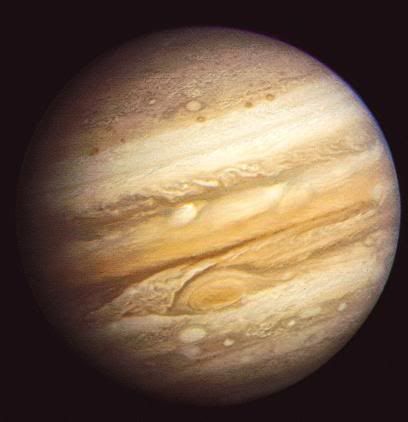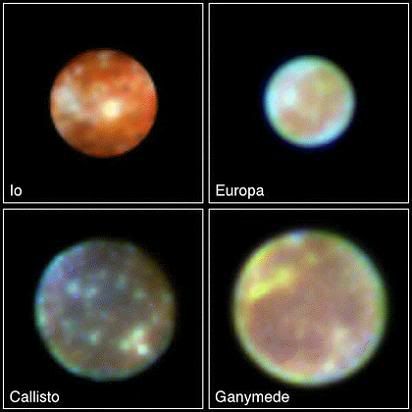Post by glactus on May 3, 2011 12:25:08 GMT
In ancient Roman religion and myth, Jupiter or Jove was the king of the gods, and the god of sky and thunder. He is the equivalent of Zeus in the Greek pantheon.
As the patron deity of ancient Rome, he ruled over laws and social order. He was one of three gods of the Capitoline Triad, along with Juno and Minerva. The most important temple of the Roman Republic was dedicated to Iuppiter Optimus Maximus ("Jupiter Best and Greatest").

The Planet Jupiter
Jupiter is the fifth planet from the Sun and by far the largest, being more than twice as massive as all the other planets combined (the mass of Jupiter is 318 times that of Earth). It is also the fourth brightest object in the sky (after the Sun, the Moon and Venus).

The Galilean moons
Jupiter's four large moons Io, Europa, Ganymede and Callisto are now known as the Galilean moons, because of their motion back and forth around Jupiter. This was the first discovery of a center of motion not apparently centered on the Earth. It was a major point in favor of Copernicus's heliocentric theory of the motions of the planets. Galileo's outspoken support of the Copernican theory got him in trouble with the Inquisition. Today anyone can repeat Galileo's observations using binoculars or an inexpensive telescope.
This behemoth planet has 63 known satellites (as of Feb 2004): the four large Galilean moons plus many more small ones some of which have not yet been named: Jupiter was first visited by Pioneer 10 in 1973 and later by Pioneer 11, Voyager 1, Voyager 2 and Ulysses. The spacecraft Galileo orbited Jupiter for eight years. It is still regularly observed by the Hubble Space Telescope.

Shoemaker Levy 9
The Great Red Spot (GRS) has been seen by Earthly observers for more than 300 years (its discovery is usually attributed to Cassini, or Robert Hooke in the 17th century). The GRS is an oval about 12,000 by 25,000 km, big enough to hold two Earths. Other smaller but similar spots have been known for decades. Infrared observations and the direction of its rotation indicate that the GRS is a high-pressure region whose cloud tops are significantly higher and colder than the surrounding regions. Similar structures have been seen on Saturn and Neptune. It is not known how such structures can persist for so long.
Jupiter is about 90% hydrogen and 10% helium (by numbers of atoms, 75/25% by mass) with traces of methane, water, ammonia and "rock". This is very close to the composition of the primordial Solar Nebula from which the entire solar system was formed. Saturn has a similar composition, but Uranus and Neptune have much less hydrogen and helium.
On the 19 of July 1994, shoemaker Levy 9 hit Jupiter leaving scars in an encounter that reminds us all that our Solar System is not yet immune from the bombardment that attributed to its creation.
See 2 movies of Shoemaker levy 9 impacts below, with sound
www.youtube.com/watch?v=vtLPnOypH3g&feature=related
www.youtube.com/watch?v=7zNuT4dbdjU&feature=related

Jupiter
Credits: Images: These are non copywrite images
Text: Wikipedia/Glactus
As the patron deity of ancient Rome, he ruled over laws and social order. He was one of three gods of the Capitoline Triad, along with Juno and Minerva. The most important temple of the Roman Republic was dedicated to Iuppiter Optimus Maximus ("Jupiter Best and Greatest").

The Planet Jupiter
Jupiter is the fifth planet from the Sun and by far the largest, being more than twice as massive as all the other planets combined (the mass of Jupiter is 318 times that of Earth). It is also the fourth brightest object in the sky (after the Sun, the Moon and Venus).

The Galilean moons
Jupiter's four large moons Io, Europa, Ganymede and Callisto are now known as the Galilean moons, because of their motion back and forth around Jupiter. This was the first discovery of a center of motion not apparently centered on the Earth. It was a major point in favor of Copernicus's heliocentric theory of the motions of the planets. Galileo's outspoken support of the Copernican theory got him in trouble with the Inquisition. Today anyone can repeat Galileo's observations using binoculars or an inexpensive telescope.
This behemoth planet has 63 known satellites (as of Feb 2004): the four large Galilean moons plus many more small ones some of which have not yet been named: Jupiter was first visited by Pioneer 10 in 1973 and later by Pioneer 11, Voyager 1, Voyager 2 and Ulysses. The spacecraft Galileo orbited Jupiter for eight years. It is still regularly observed by the Hubble Space Telescope.

Shoemaker Levy 9
The Great Red Spot (GRS) has been seen by Earthly observers for more than 300 years (its discovery is usually attributed to Cassini, or Robert Hooke in the 17th century). The GRS is an oval about 12,000 by 25,000 km, big enough to hold two Earths. Other smaller but similar spots have been known for decades. Infrared observations and the direction of its rotation indicate that the GRS is a high-pressure region whose cloud tops are significantly higher and colder than the surrounding regions. Similar structures have been seen on Saturn and Neptune. It is not known how such structures can persist for so long.
Jupiter is about 90% hydrogen and 10% helium (by numbers of atoms, 75/25% by mass) with traces of methane, water, ammonia and "rock". This is very close to the composition of the primordial Solar Nebula from which the entire solar system was formed. Saturn has a similar composition, but Uranus and Neptune have much less hydrogen and helium.
On the 19 of July 1994, shoemaker Levy 9 hit Jupiter leaving scars in an encounter that reminds us all that our Solar System is not yet immune from the bombardment that attributed to its creation.
See 2 movies of Shoemaker levy 9 impacts below, with sound
www.youtube.com/watch?v=vtLPnOypH3g&feature=related
www.youtube.com/watch?v=7zNuT4dbdjU&feature=related
Jupiter
Credits: Images: These are non copywrite images
Text: Wikipedia/Glactus


